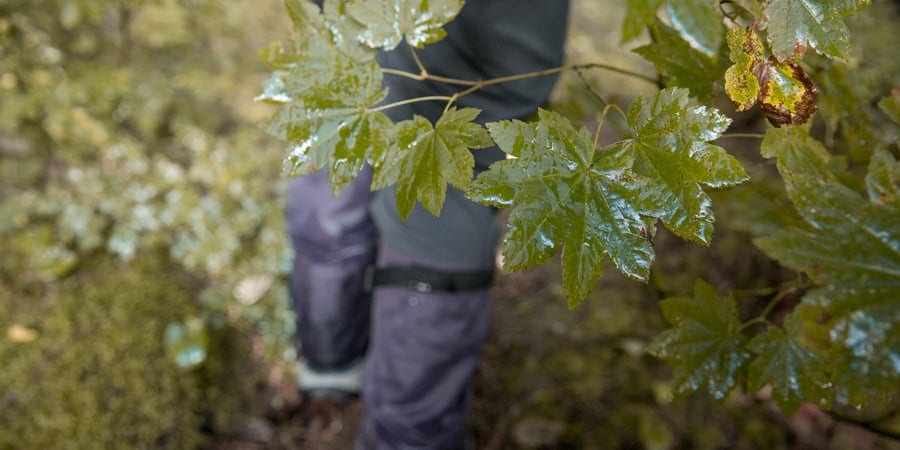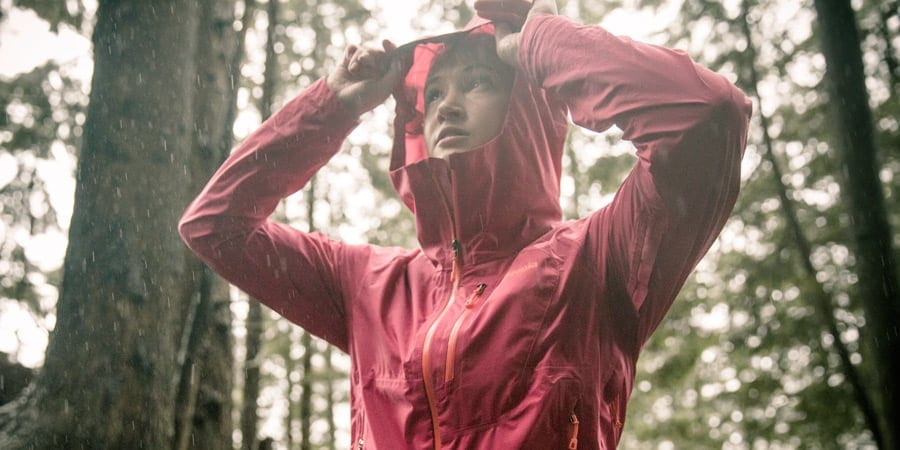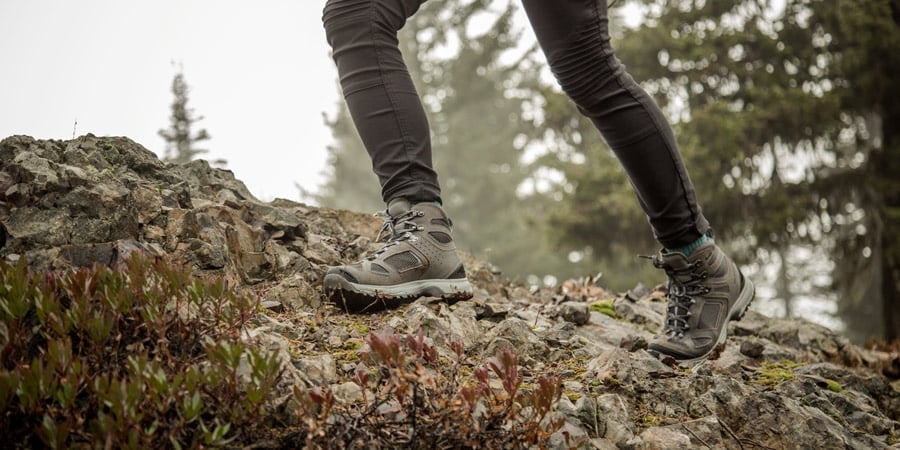Before you grumble about a gray forecast, it’s worth remembering that giant redwoods, colorful wildflowers and grandiose canyons were all made possible by the relentless pitter patter of a billion raindrops.
If you adopt the proper attitude, you can learn to love hiking in the rain. Proper prep helps, too. In this article we’ll cover the basics:
- Gearing up: Consider adding a few key items for wet-weather comfort and safety.
- Clothing tips: Learn what not to bring, and how to check your clothing for rain-readiness.
- Trail hazards: Learn how to avoid common complications.
Gearing Up for Hiking in the Rain

All trips should start with Ten Essentials. When rain is a distinct possibility, it’s also wise to adjust your gear list.
Protecting Your Gear: Because seams aren’t sealed, packs aren’t truly waterproof, especially in a downpour. In addition, all of the places that make gear accessible to you also provide a path for rain to seep in. Even zippers that are water resistant will let water sneak in eventually.
Added protection options for your pack include the following:
- Pack raincover. Some packs come with one, or you can buy a cover sized to fit your daypack.
- Lightweight dry sacks. You can use these inside your pack for your most vulnerable gear.
- Waterproof cases. Look for one that’s specially designed to fit your phone, helmet cam or other favorite gadget.
- Ziplock plastic bags. These are inexpensive, though not unfailingly waterproof nor particularly durable.
- Trash bags. On a rainy day, some might call this the Eleventh Essential. You can use the scissors on your multi-tool to fashion a crude pack cover out of one. You can also use one to double-bag important items for added protection. And it’s always a good move to use one to carry out trash you find along the trail.
Almost-Essential Wet-Weather Gear: The following items can make things easier and more enjoyable on a drippy day:
- Trekking poles. When footing is sloppy, poles can be a huge help, especially on creek crossings.
- Handwarmers.Typically considered a winter sports accessory, these work when you tear open an outer foil pouch to produce a heat packet that lasts for hours. The added warmth can lift your spirts if your extremities are getting uncomfortable.
- Extra blister supplies. Wet feet are more blister-prone feet. Read Blister Prevention and Care for more details.
- Headlamp. Because it’s one of the Ten Essentials, you should be packing it. Consider using it before dark, though, if light conditions get extra gloomy.
- Bandana or multitowel. These are handy for wiping or drying off wet gear. The bandana can be the token cotton item on your list. (Most multitowels are synthetic.)
Clothing Tips for Wet-Weather Hiking

Before you head out with the possibility of rain in the forecast, take a closer look at your clothing, including outerwear and footwear, and assess how rain-ready they are. Some things to keep in mind:
- Absolutely no cotton. This is key for next-to-skin layers because cotton holds water, including your sweat, and chills you. Go with wicking materials like wool, nylon or polyester clothing instead. Don’t think that cotton in briefs or a bra is OK either, because those are the first things search-and-rescue workers will cut off if there’s a possibility that you’re starting to get hypothermia.
- Go with synthetic insulation in your jacket. Standard down loses much of its insulating ability if you get it wet. Water-resistant down and hybrids that combine synthetic insulation and water-resistant down are your next best bet. If you’re hiking in milder weather, you can pack a lightweight fleece or soft-shell jacket instead.
- Evaluate your rainwear. If you’re considering an upgrade, read Rainwear: How to Choose. Going with bright colors can help brighten your mood on a relentlessly gray day. In an emergency, bright colors also help search teams locate you.
- Renew your rainwear’s Durable Water Repellent (DWR). If you love your current raingear, see if drops bead up and roll off. If not, renew its DWR coating to restore performance. It’s a good idea to renew your DWR coating at the beginning of every hiking season.
- Pack a rain cap. Even if your rain jacket has a brimmed hood, it does a poor job of keeping rain off your face or glasses. A rain hat should have a nice, broad brim. If you choose a ballcap-style hat, then you can wear it under the hood of your rain jacket.
- Evaluate your footwear. Waterproof boots and shoes keep feet drier initially, making them a good option for colder conditions. Renew the waterproofing at the beginning of each season, or if you notice large dark spots forming when you splosh across wet terrain. Mesh footwear works well in milder conditions, as mesh drains and dries more quickly if you land in a puddle or creek. With either option you need deep lug soles to deal with mud and superior traction to deal with slippery rocks and logs.
- Pack gaiters. They’ll shield your socks and the tops of your footwear.
- Pack dry clothes. Extra clothing is already one of the Ten Essentials. Be sure dry socks are one of the extras you bring.
Wet Weather Trail Hazards

A significant storm system can create dangers and health concerns. If you’re on the lookout, you can take steps to avoid unwanted complications.
- Slippery surfaces. Tread carefully on muddy slopes, slimy rocks and rain-slickened logs.
- Swollen creeks. Unbuckle your hipbelt before you cross, so you can easily get free of your pack if you slip and fall into a fast-moving current.
- Flash floods. If you’ll be in canyon country, check the forecasts ahead of time and keep an eye out for quickly accessible higher ground.
- Hypothermia. Watch for the “umbles”: mumbling, grumbling, stumbling and tumbling. Those are telltale signs that you need to stop, dry out and get some calories in you. And, in general, you need to eat and drink more often than you would in sunny weather. If rain discourages rest stops, drink and snack while you’re hiking.
Rainy Day Hiking Tips

With the right mindset, a rainy-day hike can be one that you remember fondly for years to come. The air is cleaner and the solitude more profound. It will take an extra precaution or two to keep things on track, though:
- Remember that staying dry is easier than drying out after you’re wet. Don’t wait to throw on your rain shell, or to take cover in a full-on rain squall.
- Keep monitoring the weather. Weather forecasting is an inexact science.
- Keep an eye out for lightning. It puts on a great show, which you won’t want to miss. However, it’s even more important that you know how to take cover. Learn more by reading Weather Basics for Backpackers.
- Constantly self-assess. Add layers or grab a snack if you’re starting to feel a little cold. And gloomy light can sap your mental state, so poll your hiking crew to be sure everyone’s still having a good time.
- Ditch destination fever. If a relentless storm makes things miserable or downright hazardous, turn around and call it a day. You’ll still have tales to tell and time for an extra hot cocoa or two to tell them over later.
Article used by permission. HWD is an REI co-op affiliate and earns a small commission from shopping links

